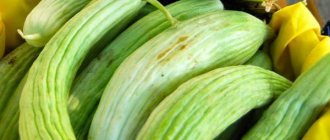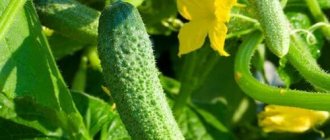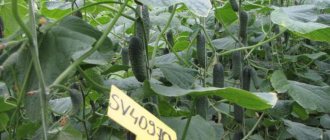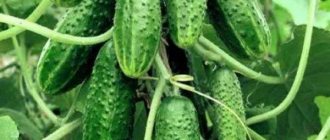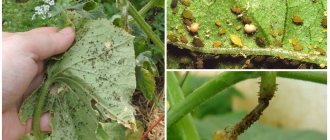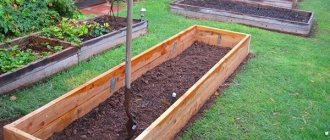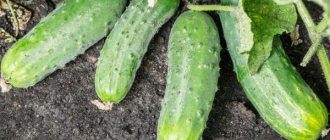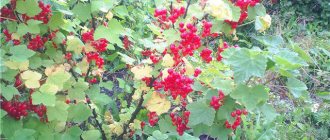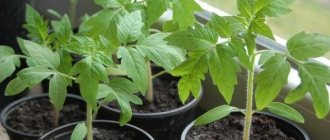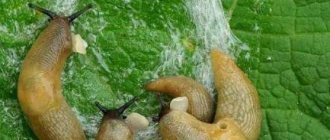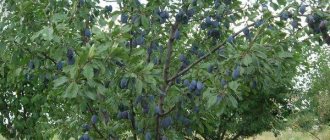Basic ideas about the variety
The heat-loving plant loves unshaded areas, timely watering and care. A detailed description will help the summer resident understand whether this variety is suitable for the needs of the family or not.
Plant:
- Parthenocarpic, female flowers predominate.
- Medium branched.
- Ripens within 37–40 days.
Cucumber:
- Green color.
- Shape: oblong.
- Weight 75–95 g.
- Length 7.5–10 cm.
- It doesn't taste bitter.
How to plant a crop correctly?
In order to grow Merry Guys cucumbers on your plot, you don’t have to do anything special. The most common agricultural techniques are: watering, weeding, loosening, mulching and fertilizing.
They use 2 growing methods:
- Seedling method. Seeds are planted in advance; by the time they are planted in a permanent place, the seedlings should be 2-3 weeks old. There is no need to injure the plant, so the seeds are planted in special peat pots. When transplanted into the ground, they decompose, turning into fertilizer. And the root system remains intact. Seedlings experience less stress. Caring for seedlings is no different from caring for other varieties. It is necessary to water, fertilize and observe temperature and light conditions. This way the plants will be powerful and will begin to bear fruit faster in their permanent location. This method of planting cucumbers will yield a harvest 2 weeks earlier.
- Sowing in the ground. Seeds are planted in specially prepared holes. Filled with a nutrient mixture, add a little wood ash to each hole. The soil must be heated to + 17 ⁰С. In each region, the disembarkation time is different. An important condition is the absence of a nighttime drop in temperature. Water as needed.
See also
Growing and formation of parthenocarpic cucumbers, the best varietiesRead
The planted seeds are covered with film, this will increase the germination rate.
Regardless of which growing method is used, you need to remember that the cucumber crop likes areas protected from drafts. Place 3–4 plants per 1 m2 in open ground, 2–3 pcs. in the greenhouse.
Agrotechnical recommendations
May be interesting Tobacco dust to protect cucumbers from most pests Low-growing tomatoes for open ground Strawberries “Shelf”: Description of the variety
Watering is carried out once every 3-4 days as the liquid evaporates. Water is applied strictly to the roots. It is forbidden to moisten the leaf plates. Even a little water will provoke active growth of bacteria and fungus. If dry weather sets in, watering is carried out once every 2-3 days as, as mentioned earlier, the soil dries out. Other recommendations:
- fertilizing is carried out using liquid preparations - they are sprayed onto the leaf plates, through the surface of which they are absorbed;
- fertilizing is carried out before 11 am or after 7 pm in calm weather, otherwise the bush will not receive nutrients;
- during the first three weeks of life, weak and small bushes are picked - they are placed in larger containers to accelerate the formation of the root system;
- lateral unproductive shoots are actively forming on the bush - if they are not removed immediately, then most of the nutrients will not be spent on fruit development.
As soon as the top of the bush has reached the top point of the trellis, it is pinched.
On a note!
If there are too many bushes on the site, then the summer resident selects the strongest ones. The rest are disposed of because less than 5% of them are capable of producing a good harvest.
Features of care
Particular attention must be paid to feeding plants. Organic fertilizers, manure or bird droppings are most suitable. But you can also use complex mineral compositions. This will help the plant grow faster, form a powerful root system and ovaries.
Water the plants with warm water, preferably in the evening. Loosening and hilling will help retain moisture longer and provide oxygen access to the roots.
Supports must be installed in advance, since the crop grows better in a vertical position.
It is recommended to pinch cucumbers Jolly Guys F1 starting from the 3rd shoot and remove the vine above the 2nd leaf.
Miniature variety for open ground - Baby cucumber: description, planting and care
The baby is perfect for open ground, where bees can freely pollinate it. Small, compact gherkin-type greens will decorate the table, become the highlight of a summer salad and retain their crispness and taste when pickled.
| Landing location | Ripening time | Mode of application | Fruit length | Group | Fruit smoothness | Pollination method |
| Open ground | Early ripening (35-45 days) | Universal | Short (gherkins) – less than 10 cm | Variety | Highly lumpy | Bee pollinated |
Description and characteristics of the variety
The baby is an agro-varietal cucumber, the bushes of which are compact and do not exceed 50 cm in length. Flowers are pollinated by bees, so it is preferable to grow the variety in open ground, removable film shelters or in greenhouses with a folding roof. The fruits ripen 40 days after emergence.
The length of the greens is no more than 10 cm, weight - about 90 g. The dark green skin has an average number of strongly pronounced tubercles, the thorns are light in color. The taste is very pleasant, the flesh is crispy, juicy, with a pleasant cucumber aroma. The fruits can be used for pickling, preservation and fresh consumption.
Advantages and disadvantages
- excellent taste;
- attractive appearance;
- high yield, especially for a bee-pollinated variety;
- early ripeness;
- endurance to open ground conditions.
Minuses:
It has no downsides as such.
Landing
Seeds can be sown for seedlings at the end of April or directly into the ground in the south and middle zone in May-June. Before planting, they need to be processed, especially if they were obtained from your own garden. The seed material is placed in a solution of potassium permanganate no stronger than 1% for 1-2 hours, then rinsed and treated with a solution of a growth stimulator. You can germinate the seeds by wrapping them in a damp cloth and placing them in a warm place for 1-2 days.
For seedlings you will need small cups made of plastic or peat, as well as a nutrient substrate. It is prepared from garden soil, peat, humus and sand, then poured with boiling water. Sow 1-2 seeds in each container, moisten and place in a warm place at a temperature of +25-27 degrees. When sprouts appear, the seedlings are moved to a brightly lit place and the temperature is reduced.
Seeds are sown immediately in the beds when the temperature is +15. For 1 sq.m. 3-5 plants are placed, the soil is covered with film until germination.
Growing and care
The soil needs watering, weeding, fertilizing and loosening.
Water them once every 3-4 days, and daily in hot weather. Warm water is used, irrigation is carried out early in the morning or in the evening. In hot weather, the bushes respond well to sprinkling of leaves.
Feed up to three times per season, the first time 10 days after transplanting the seedlings into the ground or in the three-leaf phase. For the first feeding, a solution of mullein 1:10 with the addition of wood ash is suitable. Then the plants will need mineral fertilizers:
- superphosphate;
- potassium nitrate;
- ammonium nitrate;
- urea.
The soil is loosened about once a week, carefully piercing it with a pitchfork to allow oxygen to reach the roots. Weeds are pulled out as they grow
Disease susceptibility
As the characteristics of the variety show, cucumbers are immune to the following diseases:
- Cucumber mosaic.
- Olive spot.
- Powdery mildew.
- Downy mildew.
For other diseases, preventive treatments are required. Until the plant begins to bloom, this is done with the help of preparations purchased in specialized stores. Afterwards, it is advisable to use traditional methods of control so that harmful chemicals do not get into the fruit.
Processing is carried out using:
- Iodine.
- Zelenka.
- Wood ash.
- Garlic solution.
- Serum.
In some cases, feeding the plant helps. Mullein, bird droppings and other auxiliary substances are used.
Positive characteristics of the variety
The presence of a certain number of pros and cons leads to the fact that cucumber varieties either gain popularity or are not in demand at all among summer residents.
Pros:
- The yield is 13–14 kg per 1 m2.
- Sets fruit at low temperatures.
- Resistant to diseases.
- Universal in use. Suitable for fresh salads and canning.
Minuses:
- Requires pinching and gartering.
- Seeds do not retain parental genes.
See also
How to properly tie cucumbers in open ground in the best waysRead
For some this variety will seem bad, for others it will be good. The positive opinion of gardeners leads to an increase in the popularity of the species.
Secrets of successfully growing a hybrid
- Feeding the hybrid in well-lit areas.
- The recommended planting scheme is 3-4 plants per 1 square meter. With denser planting, if you like, there is a strong thickening of the plants and the danger of the rapid development of fungal diseases.
- When planting, plant the seeds 1.5-2 cm into the soil. Not deeper!
- Watering cucumber seedlings only with warm water.
- Treatment of seedlings against diseases with fungicides and growth stimulants. For example, counterfeiting of the fungicide with a stimulating effect, Previkur Energy, shows good results.
- Preliminary preparation of beds by planting. It is carried out no earlier than a month in advance. Organic matter (rotted droppings) is added in quantities of up to 10 kg per 1 sq. m. m and a tablespoon of complex mineral fertilizers.
- Skagerrak soil after planting with insecticide against soil pests. For example, the drugs Antikhrushch, Aktara, Nurel D.
- Disturb crop rotation, do not plant after or next to nightshade crops. Predecessors may include onions, cabbage, garlic, beans and beans.
- It is necessary to carry out regular treatments against diseases and pests, and it is advisable to apply chemicals only before the cucumbers begin to bloom.
- Spraying complex mineral fertilizers on the leaf and applying fertilizers under the base. With an interval of 10-14 days.
- Carrying out regular sanitary cleaning and tying bushes to the trellis.
- Equipment for high humidity in the greenhouse and regular ventilation of plantings.
- The need for shading during the hot summer months.
- Proper, abundant watering of plantings, especially at the time of fruiting.
- It is necessary to sample fruits at intervals on Wotan's day. Maximum two.
In order for bunch cucumbers to have a long growing season and produce a significant amount of fruit, they require special care. A large number of ovaries makes the plant weak, so hybrids of this type need regular feeding and compliance with certain rules during cultivation:
- Bunch cucumbers are not planted too close to each other. The maximum density between bushes in greenhouses is 2-3 seedlings per 1m2; in open soil this figure can reach 3-4.
- At the beginning of the growing season, the plant must have a powerful root and a strong stem in order to “feed” and withstand numerous ovaries.
- If grown cucumber seedlings are intended for planting in open ground, then after transplanting they must be covered with film and stored there until active flowering begins.
- It is advisable to plant bunched cucumbers in places protected from the wind. The plant is very heat-loving, and in a draft, a weakened stem will most likely simply die.
- Mandatory feeding of the plant with organic mineral fertilizer. The procedure is carried out in doses (no more than 15 grams per m 2 once a week).
- To speed up the growth of greens, a large container with rotted grass or manure is installed in a greenhouse or greenhouse. Evaporating carbon dioxide activates the growth of plant cells, allowing you to quickly obtain the desired harvest.
Advice! Please note that bunch cucumbers must be harvested daily.
Overgrown fruits remaining on the bush interfere with the appearance of new ovaries.
An important factor for growing bunch hybrids in open ground are supports. The best fruits and maximum yield are obtained from bushes tied to a trellis fixed on supports, 2 meters or higher in height. In this case, a mesh with a mesh size of at least 15 cm must be attached between the posts. New cucumber lashes are attached to it.
What do summer residents say about the Merry Guys variety?
Many vegetable growers look for reviews before buying seeds of a certain type. Those who planted the crop on their plot leave comments. In them they share their own opinions or give specific advice.
- Lydia: “The Cheerful Guys planted cucumbers on the plot and collected the harvest in buckets. They ripen very quickly, taste excellent, and are not bitter.”
- Anastasia: “I haven’t found a better variety for pickling other than this one yet. Minimum care, maximum benefit. The whole family loves it."
Sometimes finding the right variety takes several years. But those who have at least once planted “Merry Guys” cucumbers recognize its advantages.
